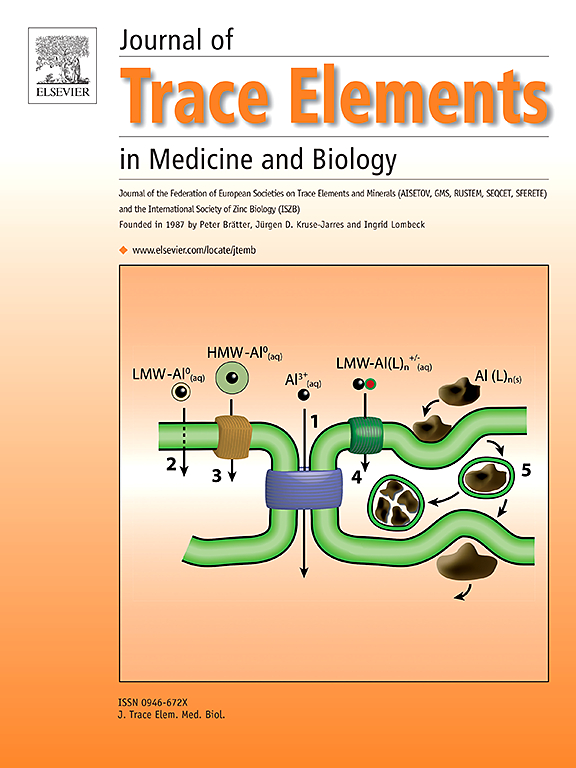Multidimensional analysis of selected bioelements in rat's brain subjected to stroke procedure and treatment with H2S donor AP-39
IF 3.6
3区 医学
Q2 BIOCHEMISTRY & MOLECULAR BIOLOGY
Journal of Trace Elements in Medicine and Biology
Pub Date : 2025-03-08
DOI:10.1016/j.jtemb.2025.127628
引用次数: 0
Abstract
Background
A stroke is characterized by a sudden disruption in blood flow to the brain. According to WHO statistics, stroke is the second most common cause of death. Its pathophysiology involves complex mechanisms: oxidative stress, inflammation, cytotoxicity and neuronal cell death. Middle cerebral artery occlusion (MCAO) in rats is commonly used to study the pathophysiology of stroke, as well as the efficacy of therapeutic strategies e.g. application of H2S donors.
Objectives
The aim of this study was to determine the concentrations of minerals (Mg, Na, K), and trace elements (Fe, Cu, and Zn) in rats brain undergoing stroke procedure in the dorsal striatum (ischemic core) and prefrontal cortex (penumbra). We also investigate the application of AP-39 on the levels of above-mentioned minerals and trace elements.
Methods
Using the MCAO rat model, the impact of stroke and treatment with 100 nmol/kg b.m. i.v. of AP-39 was examined on minerals and trace elements levels, determined by F-AAS and F-AES methods. Results were analyzed using multidimensional statistical analysis (chemometric techniques).
Results
Iron, magnesium, and zinc are the most important bioelements whose concentration changes in both investigated structures were associated with stroke symptoms. The concentrations of zinc and copper showed opposing trend. The application of AP-39 mainly affected the potassium level. In the stroke structure (DS) dosage of AP-39 decreased the potassium level and in non-stroke structure AP-39 increased potassium levels.
Conclusion
Stroke and AP-39 treatment significantly altered bioelement concentrations. The bioelements most susceptible to changes under MCAO procedures were zinc, iron and magnesium.
H2S供体AP-39治疗脑卒中大鼠脑内选定生物元素的多维分析
中风的特点是流向大脑的血液突然中断。根据世界卫生组织的统计,中风是第二大最常见的死亡原因。其病理生理涉及复杂的机制:氧化应激、炎症、细胞毒性和神经元细胞死亡。大鼠大脑中动脉闭塞(MCAO)常用于研究脑卒中的病理生理,以及应用H2S供体等治疗策略的疗效。目的测定脑卒中大鼠脑背纹状体(缺血核)和前额叶皮层(半暗带)中矿物质(Mg、Na、K)和微量元素(Fe、Cu和Zn)的浓度。我们还研究了AP-39在上述矿物质和微量元素水平上的应用。方法采用MCAO大鼠模型,采用原子吸收光谱法(F-AAS)和原子发射光谱法(F-AES)测定100 nmol/kg b.m.i.v. AP-39对脑卒中大鼠体内矿物质和微量元素含量的影响。使用多维统计分析(化学计量学技术)对结果进行分析。结果铁、镁、锌是最重要的生物元素,其浓度变化与脑卒中症状相关。锌和铜的浓度呈相反趋势。AP-39的施用主要影响钾水平。在脑卒中结构(DS)中,AP-39剂量降低了钾水平,而在非脑卒中结构(DS)中,AP-39剂量增加了钾水平。结论脑卒中和AP-39治疗可显著改变生物元素浓度。最易受MCAO程序影响的生物元素是锌、铁和镁。
本文章由计算机程序翻译,如有差异,请以英文原文为准。
求助全文
约1分钟内获得全文
求助全文
来源期刊
CiteScore
6.60
自引率
2.90%
发文量
202
审稿时长
85 days
期刊介绍:
The journal provides the reader with a thorough description of theoretical and applied aspects of trace elements in medicine and biology and is devoted to the advancement of scientific knowledge about trace elements and trace element species. Trace elements play essential roles in the maintenance of physiological processes. During the last decades there has been a great deal of scientific investigation about the function and binding of trace elements. The Journal of Trace Elements in Medicine and Biology focuses on the description and dissemination of scientific results concerning the role of trace elements with respect to their mode of action in health and disease and nutritional importance. Progress in the knowledge of the biological role of trace elements depends, however, on advances in trace elements chemistry. Thus the Journal of Trace Elements in Medicine and Biology will include only those papers that base their results on proven analytical methods.
Also, we only publish those articles in which the quality assurance regarding the execution of experiments and achievement of results is guaranteed.

 求助内容:
求助内容: 应助结果提醒方式:
应助结果提醒方式:


